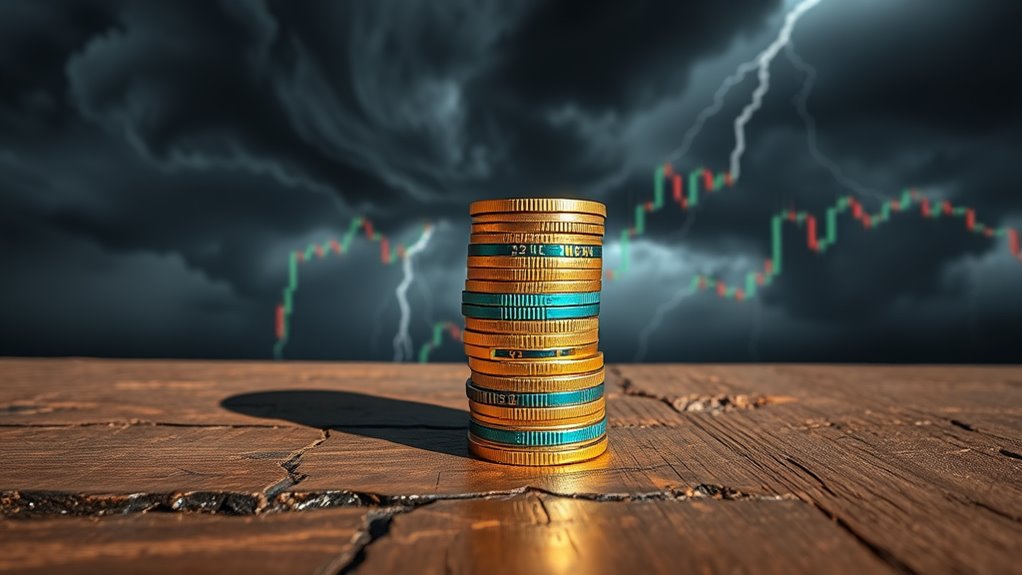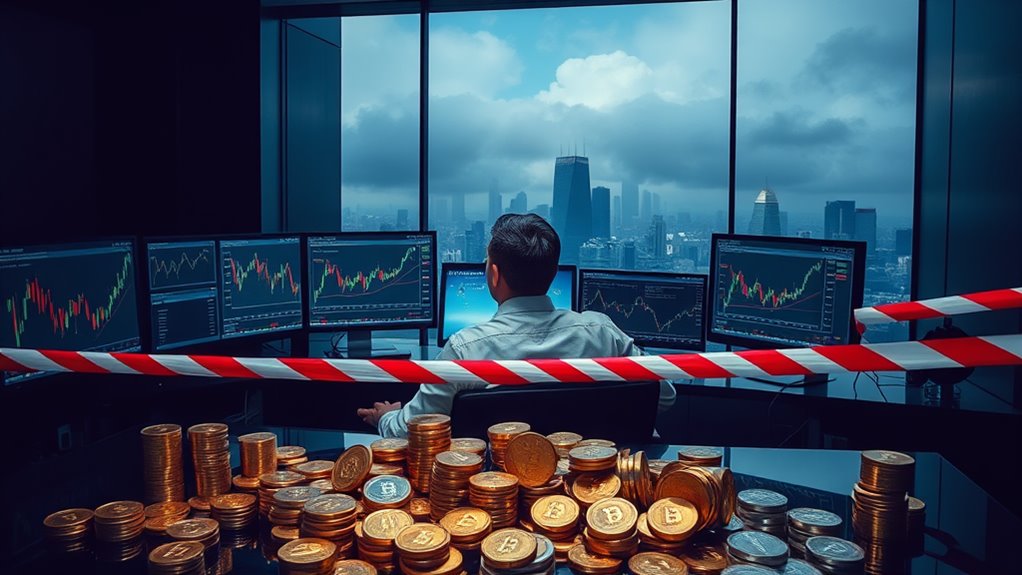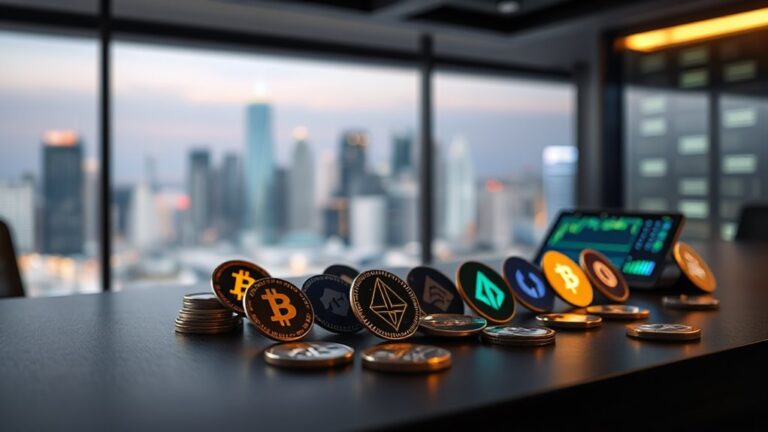
Risks of Investing in Altcoins: Essential Considerations for Investors
Investing in altcoins involves significant risks due to high market volatility, liquidity challenges, and regulatory uncertainties. Investors face potential vulnerabilities in blockchain and smart contracts, along with scams such as Ponzi schemes and fake ICOs. Thorough research and strategic planning are essential, including diversification, evaluating real-world applications, and appraising the development team's expertise. Monitoring market dynamics and regulatory compliance can further help mitigate risks. There are avenues to explore that offer a deeper understanding of these investment complexities.
Key Takeaways
- Altcoins experience high volatility, leading to rapid price fluctuations and increased investment risk.
- Regulatory uncertainty complicates legal compliance and can affect altcoin valuation.
- Liquidity challenges can result in difficulties buying or selling at fair prices.
- Security vulnerabilities in blockchain and smart contracts can undermine investment integrity.
- Scams like Ponzi schemes and fake ICOs pose significant risks to altcoin investors.
Understanding Market Volatility

Understanding market volatility is essential when investing in altcoins, as these digital currencies often experience higher volatility than Bitcoin, leading to rapid and sometimes unpredictable price fluctuations.
This heightened volatility can result in significant gains or losses, positioning altcoin investments as riskier endeavors compared to traditional assets like stocks. Historically, some altcoins have experienced price drops exceeding 90% before potentially recovering, underscoring the volatility's potential impact.
Factors such as market sentiment, regulatory changes, and global events heavily influence these fluctuations. The speculative nature of altcoins, coupled with limited media coverage, further contributes to their volatility.
The lack of regulatory clarity across different regions adds another layer of complexity, making it vital for investors to remain informed about potential regulatory impacts on altcoin prices.
Moreover, layer-2 scaling solutions are being developed to address some of the issues related to transaction speed and cost, which can also affect market dynamics and investor confidence.
Navigating Liquidity Challenges

Investors venturing into altcoins must also be prepared to face liquidity challenges, which present additional risks compared to the volatility discussed earlier. The cryptocurrency market is experiencing a deepening liquidity crisis, with altcoins seeing a more severe impact due to declining trading volumes. This makes it difficult to buy and sell at fair prices. Thinning market depth contributes to extreme price movements, and low liquidity can result in significant price fluctuations, making altcoins susceptible to manipulation. Analysts predict these challenges may persist through late 2025 or early 2026. Factors such as excess supply, dwindling capital inflows, and lack of buyer support contribute to low liquidity. Additionally, the anticipated institutional adoption of cryptocurrencies could help alleviate some of the liquidity issues by increasing capital inflows and buyer support, thereby stabilizing the market.
| Factor | Impact on Liquidity |
|---|---|
| Excess Supply | Reduced demand |
| Dwindling Capital Inflows | Lower market liquidity |
| Lack of Buyer Support | Reduced trading activity |
| Market Sentiment | Dampened investor confidence |
Regulatory Landscape and Its Impacts

The regulatory landscape for altcoins is constantly changing, creating challenges in legal classification and compliance for investors and businesses alike. Many countries struggle with how to categorize altcoins, whether as securities, commodities, or something entirely new, leading to varied taxation and compliance requirements. Thoughtful regulation might legitimize cryptocurrencies while preventing their use in illicit activities. This evolving environment creates uncertainty, as investors must navigate different regulations across jurisdictions, impacting the overall adoption and trading of altcoins.
Evolving Regulatory Environment
As the regulatory environment for altcoins evolves, it presents both challenges and opportunities for investors and businesses. The landscape is marked by regulatory uncertainty as countries adopt diverse strategies, ranging from El Salvador's full embrace of cryptocurrencies to China's strict controls.
For investors, several key points are significant:
- Regulatory Uncertainty: Global crypto regulations vary widely, making the landscape complex and difficult to navigate.
- EU's MiCA Regulation: The European Union aims to create a cohesive framework to standardize rules across member states, promoting consistency.
- U.S. Regulatory Shifts: The SEC's changing stance, such as classifying proof-of-work cryptocurrencies as commodities, affects market dynamics.
- Global Collaboration Trends: Increasing collaboration among jurisdictions seeks to harmonize rules, potentially reducing cross-border regulatory challenges.
Additionally, investors should consider portfolio diversification as a risk management strategy, which involves spreading investments across various assets to mitigate potential losses due to regulatory changes.
These factors influence investor confidence and market stability.
Legal Classification Challenges
How do the complexities of legal classification impact the cryptocurrency world?
The global nature of cryptocurrencies clashes with national regulatory frameworks, leading to jurisdictional issues. Regulatory arbitrage allows companies to operate in countries with lenient laws, while differing national regulations complicate compliance and enforcement. For example, many exchanges choose regulation-friendly countries like Malta.
The lack of consensus on classifying cryptocurrencies—as currencies, commodities, or securities—adds to the challenge. In the U.S., the SEC often labels tokens as securities, whereas the CFTC treats Bitcoin as a commodity. This classification affects taxation, trading, and compliance.
Regulatory enforcement is difficult due to the absence of a centralized body, and evolving international regulations further highlight the need for global cooperation to guarantee consistent standards. Understanding blockchain technology is crucial as it underpins how digital currencies function and interact with these varying legal landscapes.
Taxation and Compliance Issues
Why do taxation and compliance issues pose significant challenges for altcoin investors? The complexities arise from various factors that hinder accurate reporting and compliance with tax regulations.
- Reporting Requirements: Many transactions happen on unregulated exchanges, making it hard for investors to report them to tax authorities accurately.
- Regulatory Framework: The absence of centralized regulation increases the difficulty for taxpayers to accurately report their transactions, leading to potential errors.
- Calculation of Cost Basis: Investors find it challenging to determine the cost basis for altcoins, especially when traded across multiple platforms with incomplete transaction histories.
- Penalties for Non-Compliance: Failing to report correctly can result in significant penalties, including fines and potential legal actions, emphasizing the importance of compliance.
Additionally, investors can potentially reduce their tax burden through legal methods like tax-loss harvesting, which involves selling investments at a loss to offset gains elsewhere.
Understanding these challenges is essential for altcoin investors.
Addressing Technological Vulnerabilities

When it comes to investing in altcoins, technological vulnerabilities pose significant risks that investors must understand.
Altcoins rely heavily on blockchain technology, which can be vulnerable to several security threats. These include 51% attacks, where a single entity gains control of the network, and smart contract vulnerabilities, such as reentrancy and integer overflow attacks, which can lead to fund loss.
Routing attacks may interfere with transaction processes, while consensus algorithm exploits can undermine blockchain integrity. Additionally, smart contracts are susceptible to bugs, timestamp manipulation, and front-running, compromising their reliability.
To mitigate these risks, regular audits and testing are essential. Implementing robust encryption, identity verification, and advanced consensus mechanisms can enhance network security, safeguarding investors from potential losses. As a foundational step, investors should familiarize themselves with using strong passwords and enabling two-factor authentication to further protect their digital assets.
Identifying Investment Risks and Scams

Investing in altcoins can be fraught with various risks and scams, making it essential for investors to exercise caution. Understanding the landscape of potential threats is vital for safeguarding investments.
Common scams include:
- Ponzi schemes: These promise high returns with minimal risk, using new investors' money to pay earlier ones.
- Phishing attacks: They target individuals through misleading emails to steal private keys or passwords.
- Fake ICOs: These attract investors with unrealistic promises and often lack real projects or development.
- Pump and dump schemes: These artificially inflate altcoin prices for profit before a subsequent drop.
Altcoins also bring distinct technological innovations to the blockchain space, which can impact their value and risk profile. Recognizing warning signs, such as guaranteed returns and lack of transparency, helps in identifying fraudulent schemes and protecting investments.
Managing Financial Exposure

Investors must carefully manage their financial exposure when considering altcoins, as these digital assets are highly volatile and can lead to substantial financial risks. Limiting investments to funds that one can afford to lose is vital, as high-risk investments necessitate a thorough evaluation of financial capabilities. Overleveraging should be avoided to prevent excessive financial exposure. Maintaining financial stability outside of altcoin investments is advisable. Diversification across multiple altcoins can mitigate risks but cannot completely eliminate financial exposure. Market volatility, characterized by unpredictable price changes, underscores the importance of regular market analysis and using stop-loss orders to curb potential losses. Additionally, evaluating market liquidity is essential, as lower liquidity can complicate large transactions and result in significant price fluctuations. Incorporating risk management principles into your strategy can further help investors minimize losses and navigate the volatile altcoin market effectively.
Strategic Approaches to Altcoin Investment

Although altcoins present enticing investment opportunities, a strategic approach is essential to navigate their complexities and maximize potential returns.
Investors can benefit from diversification, which spreads risk and potentially increases returns. Here are key strategies:
- Portfolio Diversification: Selecting coins from various blockchain ecosystems like Ethereum, Solana, and Polkadot can enhance diversity and manage risk effectively.
- Coin Selection: Prioritize coins with higher market caps and liquidity for more stability and reduced volatility.
- Altcoin Types: Consider a mix of speculative and utility coins, alongside DeFi, privacy, and stablecoins to balance risk and opportunities.
- Technical Indicators: Utilize tools like moving averages and RSI to make informed decisions, complemented by timing strategies like setting stop-loss orders and target profits.
When considering altcoin investments, it is important to evaluate real-world applications that showcase the potential for significant growth, as these factors can determine long-term success.
These approaches offer a foundation for thoughtful altcoin investment.
Conducting Thorough Research and Due Diligence

Effectively maneuvering the altcoin market requires more than just strategic investment approaches; it necessitates thorough research and due diligence. Investors should explore an altcoin's innovative technology, including its blockchain integration and smart contract capabilities. Evaluating energy efficiency and scalability is essential for understanding long-term viability. Analyzing the development team is equally important, focusing on their expertise, track record, and community engagement. Market dynamics such as market capitalization and trading volume can indicate potential growth and stability. Additionally, regulatory compliance, legal challenges, and government recognition are key considerations. Finally, community support and ecosystem development provide insights into an altcoin's sustainability and adoption potential.
| Research Focus | Key Consideration |
|---|---|
| Technology Evaluation | Innovative Features, Scalability |
| Team Analysis | Expertise, Transparency |
| Market Dynamics | Market Cap, Trading Volume |
| Regulatory Compliance | Legal Challenges, Government Support |
| Community Engagement | Ecosystem Development, User Adoption |
Frequently Asked Questions
How Can I Protect My Altcoin Investments From Cybersecurity Threats?
Investors can protect altcoin investments by using verified software, enabling two-factor authentication, and securing wallet keys with strong encryption. Regular updates, offline backups, and staying informed about cybersecurity threats are also essential measures for safeguarding assets.
What Role Do Altcoin Communities Play in Investment Decisions?
"A chain is only as strong as its weakest link." Altcoin communities influence investment decisions through social sentiment, governance participation, and market perception, providing valuable insights that guide investors in evaluating project legitimacy and potential growth.
How Might Geopolitical Events Impact Altcoin Markets?
Geopolitical events can considerably influence altcoin markets by triggering regulatory changes, exacerbating volatility, or causing market manipulation. Economic sanctions and geopolitical tensions may lead to increased adoption or innovation, affecting demand and market dynamics unpredictably.
Are There Psychological Biases That Affect Altcoin Investment Decisions?
Investors' minds, like turbulent seas, can be swayed by biases such as confirmation bias, loss aversion, and herd mentality. These psychological factors often lead to irrational decisions, complicating altcoin investments and amplifying market uncertainties.
How Can Emerging Altcoin Trends Be Identified Early?
Emerging altcoin trends can be identified by monitoring social media, engaging in cryptocurrency forums, staying updated with industry news, tracking new exchange listings, and observing technological advancements like DeFi integration, NFT adoption, and blockchain innovations.
Conclusion
In the intricate world of altcoin investment, traversing the landscape requires careful consideration of potential pitfalls. Investors must remain vigilant, recognizing the ever-present shifts in market dynamics, liquidity constraints, and regulatory nuances. Technological vulnerabilities and the specter of scams necessitate a prudent approach, while financial exposure should be thoughtfully managed. By employing strategic methodologies and conducting thorough research, investors can mitigate risks and make informed decisions. Ultimately, a balanced and educated approach guarantees a more secure investment journey.












